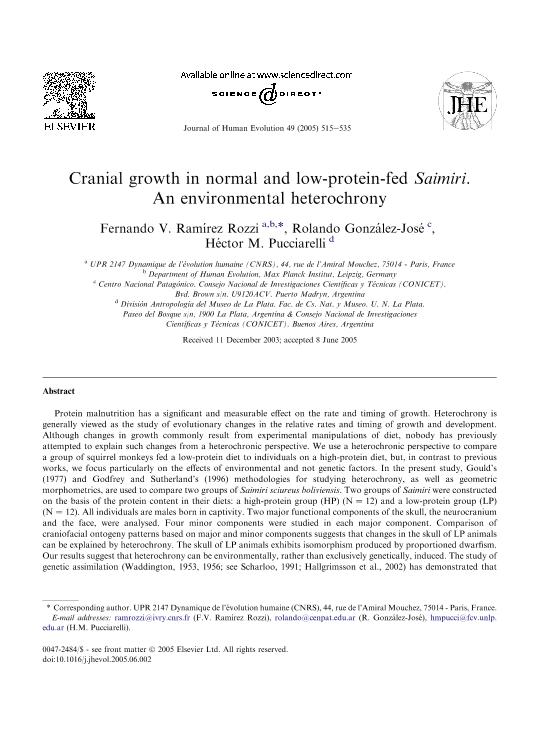Artículo
Cranial growth in normal and low-protein-fed Saimiri: An environmental heterochrony
Fecha de publicación:
10/2005
Editorial:
Academic Press Ltd - Elsevier Science Ltd
Revista:
Journal Of Human Evolution
ISSN:
0047-2484
Idioma:
Inglés
Tipo de recurso:
Artículo publicado
Clasificación temática:
Resumen
Protein malnutrition has a significant and measurable effect on the rate and timing of growth. Heterochrony is generally viewed as the study of evolutionary changes in the relative rates and timing of growth and development. Although changes in growth commonly result from experimental manipulations of diet, nobody has previously attempted to explain such changes from a heterochronic perspective. We use a heterochronic perspective to compare a group of squirrel monkeys fed a low-protein diet to individuals on a high-protein diet, but, in contrast to previous works, we focus particularly on the effects of environmental and not genetic factors. In the present study, Gould´s (1977) and Godfrey and Sutherland´s (1996) methodologies for studying heterochrony, as well as geometric morphometrics, are used to compare two groups of Saimiri sciureus boliviensis. Two groups of Saimiri were constructed on the basis of the protein content in their diets: a high-protein group (HP) (N = 12) and a low-protein group (LP) (N = 12). All individuals are males born in captivity. Two major functional components of the skull, the neurocranium and the face, were analysed. Four minor components were studied in each major component. Comparison of craniofacial ontogeny patterns based on major and minor components suggests that changes in the skull of LP animals can be explained by heterochrony. The skull of LP animals exhibits isomorphism produced by proportioned dwarfism. Our results suggest that heterochrony can be environmentally, rather than exclusively genetically, induced. The study of genetic assimilation (Waddington, 1953, 1956; see Scharloo, 1991; Hallgrimsson et al., 2002) has demonstrated that environmentally induced phenotypes often have a genetic basis, and thus parallel changes can be easily induced genetically. It is possible that proportioned dwarfism is far more common than currently appreciated.
Archivos asociados
Licencia
Identificadores
Colecciones
Articulos(CCT - LA PLATA)
Articulos de CTRO.CIENTIFICO TECNOL.CONICET - LA PLATA
Articulos de CTRO.CIENTIFICO TECNOL.CONICET - LA PLATA
Articulos(CCT-CENPAT)
Articulos de CTRO.CIENTIFICO TECNOL.CONICET - CENPAT
Articulos de CTRO.CIENTIFICO TECNOL.CONICET - CENPAT
Citación
Ramirez Rozzi, Fernando; González José, Rolando; Pucciarelli, Hector Mario; Cranial growth in normal and low-protein-fed Saimiri: An environmental heterochrony; Academic Press Ltd - Elsevier Science Ltd; Journal Of Human Evolution; 49; 4; 10-2005; 515-535
Compartir
Altmétricas




